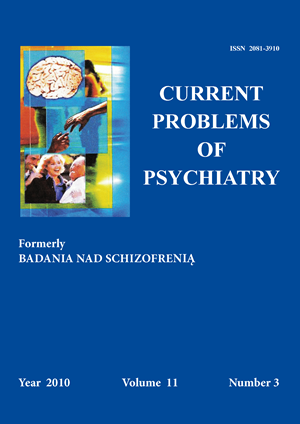Symptoms of eating disorders and narcissistic features in female athletes
Keywords:
eating disorders, fitness, athletes, womenAbstract
The purpose of the study was to investigate whether female athletes differ from non-athletes (control group) in respect of body image, narcissistic features and severity of eating disorders.
Examined group: There were examined 30 women who exercise regularly at the gym (clinical group) and 30 women who do not exercise at the gym (control group). The average age of respondents from both groups was 24.5 years. The body mass index was about 21 in clinical and control group.
Methods: The study used the survey by Zofia Stankiewicz, the Eating Disorder Inventory (EDI) by D.M. Gar-ner, M.P. Olmsted and J. Polivy and the Narcissism Inventory by F. Deneke, B. Hilgenstock and R. Müller, adapted in Polish by Januszewski.
Results: On the basis of statistical analysis the presence of significant differences in self-image, eating disorder symptoms and narcissistic features between female athletes training at the gym and non-athletes, were reported.
Conclusions: 1. Female athletes compared to non-athletes are characterized by more negative body image, which they perceive as disproportionate and too fat. 2. Female athletes compared to non-athletes more often exhibit disordered eating behaviour: dieting, using laxatives, using medications that inhibit appetite and overeating. 3. With regard to personality, female athletes in comparison with non-athletes are characterized by greater tendency to: escape from reality into a dream world, abandon their efforts and expect from others assistance, support, advice and they make instrumental use of others. 4. Female athletes are confident of being guided by more subtle, carefully considered and timeless moral principles than other people.
References
1. Otis C.L., Drinkwater B., Johnson M., Loucks A., The Female Athlete Triad. J. Med. Sci. Sports Exerc., 1997; 29(5): i-ix.
2. Golden N.H. A review of the female athlete triad (amenorrhea, osteoporosis and disordered eating). Int. J. Adolesc. Med. Health, 2002; 14(1): 9-17.
3. Benson J.E., Engelbert-Fenton K.A., Eisenman P.A. Nutritional aspects of amenorrhea in the female athlete triad. In.t J. Sport Nutr., 1996; 6(2): 134-145.
4. Nattiv A., Loucks A.B., Manore M.M., Sanborn C.F., Sundgot-Borgen J., Warren M.P. The female athlete triad. Med. Sci. Sports Exerc., 2007; 39(10): 1867-1882.
5. Warren M.P., Perlroth N.E. The effects of intense exercise on the female reproductive system. J Endocrinol. 2001 Jul;170(1):3-11.
6. Stafford D.E. Altered hypothalamic-pituitary-ovarian axis function in young female athletes: implications and recommendations for management. Treat. Endocrinol., 2005; 4(3): 147-154.
7. Dadgostar H., Razi M., Aleyasin A., Alenabi T., Dahaghin S. The relation between athletic sports and prevalence of amenorrhea and oligomenorrhea in Iranian female athletes. Sports Med. Arthrosc. Rehabil. Ther. Technol., 2009; 1: 16.
8. Sundgot-Borgen J. Risk and trigger factors for the development of eating disorders in female elite athletes. Med. Sci. Sports Exerc., 1994; 26(4): 414-419.
9. Mond J.M., Calogero R.M. Excessive exercise in eating disorder patients and in healthy women. Aust. N. Z. J. Psychiatry, 2009; 43(3): 227-234.
10. Holm-Denoma J.M., Scaringi V., Gordon K.H., Van Orden K.A., Joiner T.E. Jr. Eating disorder symptoms among undergraduate varsity athletes, club athletes, independent exercisers, and nonexercisers. Int. J. Eat. Disord., 2009; 42(1): 47-53.
11. Segura-García C., Ammendolia A., Procopio L., Pappaianni M.C., Sinopoli F., Bianco C., De Fazio P., Capranica L. Body Uneasiness, Eating Disorders, and Muscle Dysmorphia in Individuals Who Overexercise. Strength Cond. Res., 2010.
12. Goldfield G.S. Body image, disordered eating and anabolic steroid use in female bodybuilders. Eat. Disord., 2009; 17(3): 200-210.
13. Davis C., Body image and weight preoccupation: A comparison between exercising and non-exercising women. Appetite, 1990; 15(1): 13-21.
14. Steinberg B.E., Shaw R.J. Bulimia as a disturbance of narcissism: self-esteem and the capacity to self-soothe. Addict. Behav., 1997; 22(5), 699-710.
15. Gardner D.M., Olmsted M.P., Polivy J. The development and validation of a multidimensional Eating Disorder Inventory for anorexia nervosa and bulimia. Int. J. Eat. Disord., 1983; 2: 15-34.
16. Deneke F.W., Hilgenstock B. Das Narzissmusinventar. Bern, Stuttgart, Toronto; Huber: 1989.
17. Karwautz A., Völkl-Kernstock S., Nobis G., Kalchmayr G., Hafferl-Gattermayer A., Wöber-Bingöl C., Friedrich M.H. Characteristics of self-regulation in adolescent patients with anorexia nervosa. Br. J. Med. Psychol., 2001; 74(1): 101-114.
18. Bruch H. The changing picture of illness: anorexia nervosa in treatment and the therapeutic process. Madison; International University Press: 1987.
19. Drozdowski P. Wskazania do psychodynamicznej terapii zaburzeń odżywiania się. W: Bomba J., Józefik B. red., Leczenie anoreksji i bulimii psychicznej: co, kiedy, komu. Kraków; Biblioteka Psychiatrii Polskiej: 2003, s. 55-61.
20. Januszewski A. Kwestionariusz Narcyzmu. Wartość diagnostyczna w świetle wyników badań polskiej młodzieży. W: Oleś P. red., Wybrane zagadnienia z psychologii klinicznej i osobowości. Metody diagnostyczne w badaniach dzieci i młodzieży. Lublin; Towarzystwo Naukowe KUL: 2005, s. 153-196.


